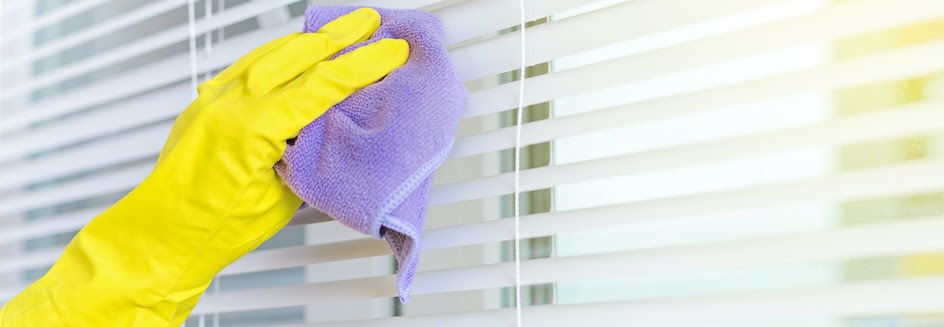Your home design items — including window treatments — should be functional and stylish yet easy to maintain. No one wants to spend hours on end cleaning or maintaining window coverings. Especially when you can spend that time enjoying your family, chasing your passions and appreciating the things in life that really matter. Fortunately, there are several different blind styles that are not only gorgeous, but also low-maintenance and simple to clean.
Here, we’ll show you which blinds are easiest to clean - looking at everything from soft roman blinds to sturdy wooden blinds. Our ranked order will help you find everything from the lowest-maintenance blinds to some that require additional attention. That way, you can find the perfect balance between style and care to fit your personal preferences and home needs.
Which Blinds Are Easiest To Clean?
The good news is that blinds generally don’t require a ton of maintenance. Most blinds need a brief dusting every few weeks and the occasional deep clean if they happen to get dirty or grimy. However, some styles may require extra thought and attention when cleaning to avoid damaging the materials.
Here, we’ve ranked blinds in order from the easiest to clean to the ones that take a little more time and dedication. Read on to find out which blinds are easiest to clean so you can find the perfect window blinds for your home.
1. Vertical Blinds
Arguably the easiest blinds to clean, vertical blinds feature long slats that run up and down rather than side to side. That means these versatile blinds collect less dust and dirt compared to horizontal blinds since the dust falls to the floor instead of on the vertical slats.
These blinds come in fabric and PVC styles, with PVC being the lowest maintenance. Here’s a quick rundown on how to clean vertical blinds. With fabric vertical blinds, you need to use a vacuum cleaner on occasion to keep them looking their best. PVC vertical blinds, on the other hand, can simply be dusted every few weeks using a feather duster.
2. Roller Blinds
Like vertical blinds, roller blinds are incredibly easy to maintain. These blinds come in a huge range of fabrics from blackout and waterproof styles to fire-resistant and thermal designs. You’ll also find delicate silk fabrics and thin voile materials. Heavy-duty waterproof roller blinds are the easiest to maintain while delicate silk roller blinds require a bit more effort.
To clean most roller blinds, simply vacuum using an upholstery brush attachment every few weeks. Alternatively, you can wipe down the fabric using a slightly damp microfibre cloth. For delicate silk roller shades, you may need to remove the fabric and have them dry cleaned. Pay close attention to the fabric of your roller blind and follow care instructions for the best results.
3. Honeycomb and Cellular Shades
Honeycomb blinds are a popular choice for people who want thermal blinds. These blinds feature a cellular construction that creates an insulating layer. They can be used to trap heat in your home when it's cold or to block hot sunlight out when the temperatures are rising. In turn, they can help you save money when it comes to heating and air conditioning bills.
While energy-efficient, these blinds are also incredibly easy to clean. They are typically made of hardy, anti-static fabrics that repel dust. That means you won’t have to clean them as often as other fabric blinds. Just vacuum the blinds when you start to see dust collecting on the window shades.
4. Aluminium Venetian and Faux Wood Blinds
Venetian blinds are horizontal blinds made from various materials including real and faux wood, PVC and metals like aluminium. Aluminium, PVC and faux wood blinds are among the easiest styles to clean. These materials are durable so they won’t get damaged if they get wet. While easy to maintain, these blinds take longer to clean since you’ll have to wipe down or vacuum each individual slat.
To clean venetian blinds, dust each slat using a microfibre cloth or feather duster every few weeks. If you keep the slats tilted slightly, you’ll need to clean them less often as they won’t collect as much dust. If you’ve forgotten to clean your hardy venetian blinds, you may need to start by vacuuming the slats and then follow up by cleaning with a damp cloth to remove grime build-up.
5. Roman Blinds
Similar to roller blinds, Roman blinds are made of a huge range of fabrics. The main difference is that Roman blinds feature elegant folds when the blind is raised. If you often have your roman blinds in the open position, they can collect dust more quickly compared to other blind styles. In addition, Roman blinds often feature soft fabrics, so you’ll have to take extra care to make sure you don’t tear or damage the fabric when cleaning.
To make cleaning Roman blinds easier, operate the blinds on a regular basis or keep them in the closed position whenever possible. This can help to limit dust collection in the pleats. For regular maintenance, vacuum the fabric gently using an upholstery brush. If the blind fabric gets stained, you may need to hire a professional dry cleaner to get them in tip-top shape without damaging the fabric.
6. Real Wood Venetian Blinds
Real wood blinds offer a natural aesthetic, but they do require more attention when it’s time to clean them. That’s mainly because wood warps when it gets wet. Wood has tiny little pores that absorb moisture, causing the wood to expand. When the wood dries out, the pores contract, causing the blind to warp and bend.
That means you can’t just use a wet towel to wipe down these blinds. Instead, you’ll have to take a few precautions when cleaning wood blinds. You’ll need to either vacuum each slat with a soft brush attachment or use a very slightly damp cloth. Limit the amount of warm water you use for cleaning these blinds and make sure to dry the slats completely as soon as possible.
Wood also doesn’t interact well with chemicals. That means you can’t use any old cleaning product to remove tough stains or grime. Limit the use of cleaning products on your wood blinds. When you absolutely have to use a product, select one that is safe for use on the type of wood your blind is made of and use sparingly.
7. Skylight Blinds
Skylights are an incredible way to let more light into your home and brighten up a room. While they are absolutely gorgeous, they are also incredibly difficult to clean. That’s not a direct result of the material of the blinds — most are made of aluminium and other hardy materials — but rather because they are often hard to reach.
By nature, skylight blinds are mounted into the ceiling. That means you’ll likely need a step stool or even a ladder to clean these blinds. That can be a lot of hassle if you have to drag a ladder out of the garage every few weeks just to do a little dusting. If you’re dying to have a skylight blind, invest in a long feather duster or similar tool to make cleaning easier.
Tips for Cleaning Your Blinds
Whether you have real wood blinds or hardy roller blinds, taking care of your window dressings means making conscious decisions about the tools and techniques you use. Here are some useful tips to help you keep your blinds sparkling clean without harming the materials.
— Use a clean cloth when wiping down your blinds. Dirty rags and old towels may have traces of chemicals or grime that can damage your blinds or even make them dirtier.
— Use a soft material when choosing cleaning tools. Microfibre and 100% cotton cloths are the best choice as they can collect dirt and dust without scratching delicate materials such as wood.
— Limit the use of cleaning products and use plain warm water with a small amount of dish soap when needed. Chemicals such as bleach and natural cleaners like apple cider vinegar can damage or discolour fabrics. Cleaners can also damage control mechanisms such as chains so limit their use whenever possible.
— Wipe blinds in the direction of the fabric weave or the wood grain. This helps to prevent scuffs and scratches that damage the look and integrity of your blinds.
— Look for fabric blinds that are made with anti-static fabrics including cotton and rayon. These fabrics attract less dust, making them lower maintenance.
Need more help when it comes to cleaning blinds? Check out our guide on how to clean blinds where we break down cleaning tips for each type of blind. You’ll find tips on regular cleaning as well as insider know-how on how to spot clean and wipe clean various blind styles.



